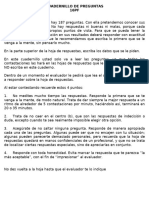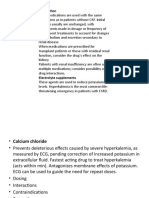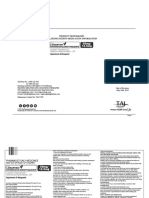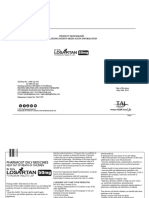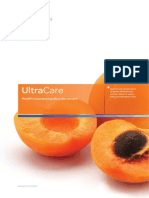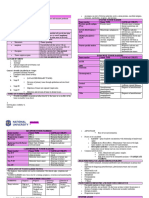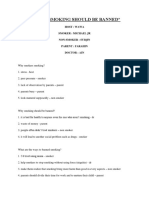Paclitaxel For Injection Usp 6 MG Per ML (Package Leaflet) - Taj Pharma
Paclitaxel For Injection Usp 6 MG Per ML (Package Leaflet) - Taj Pharma
Uploaded by
TAJ PHARMA — A Health Care ProviderCopyright:
Available Formats
Paclitaxel For Injection Usp 6 MG Per ML (Package Leaflet) - Taj Pharma
Paclitaxel For Injection Usp 6 MG Per ML (Package Leaflet) - Taj Pharma
Uploaded by
TAJ PHARMA — A Health Care ProviderOriginal Title
Copyright
Available Formats
Share this document
Did you find this document useful?
Is this content inappropriate?
Copyright:
Available Formats
Paclitaxel For Injection Usp 6 MG Per ML (Package Leaflet) - Taj Pharma
Paclitaxel For Injection Usp 6 MG Per ML (Package Leaflet) - Taj Pharma
Uploaded by
TAJ PHARMA — A Health Care ProviderCopyright:
Available Formats
PACLITAXEL INJECTION USP, paclitaxel ep monograph, paclitaxel mechanism of action, taxol injection, paclitaxel chemotherapy, paclitaxel side effects,
paclitaxel class, paclitaxel adverse effects, paclitaxel indication, paclitaxel injection price, paclitaxel injection side effects, paclitaxel injection 100mg, paclitaxel chemotherapy, paclitaxel dose, paclitaxel side effects, paclitaxel mechanism of action, taxol cumulative effect, PACLITAXEL, paclitaxel chemotherapy, paclitaxel dose, paclitaxel and carboplatin, paclitaxel side effects, paclitaxel moa, paclitaxel price, paclitaxel adverse effects, paclitaxel success rates, Paclitaxel (PTX), sold under the brand name T
axol among others, is a chemotherapy medication used to treat a number of types of cancer.
This includes ovarian cancer, breast cancer, lung cancer, Kaposi sarcoma, cervical cancer, and pancreatic cancer. It is given by injection into a vein.,
Paclitaxel
Trade Names: Taxol®, OnxalTM
Drug Type:
Paclitaxel is an anti-cancer ("antineoplastic" or "cytotoxic") chemotherapy drug. Paclitaxel is classified as a "plant alkaloid," a "taxane" and an "antimicrotubule agent." (For more detail, see "How Paclitaxel Works" section below).
What Paclitaxel Is Used For:
Treatment of breast, ovarian, lung, bladder, prostate, melanoma, esophageal, as well as other types of solid tumor cancers. It has also been used in Kaposi's sarcoma.
Note: If a drug has been approved for one use, physicians may elect to use this same drug for other problems if they believe it may be helpful.
How Paclitaxel Is Given:
Paclitaxel is given as an injection or infusion into the vein (intravenous, IV).
Paclitaxel is an irritant. An irritant is a chemical that can cause inflammation of the vein through which it is given. If the medication escapes from the vein it can cause tissue damage. The nurse or doctor who gives Paclitaxel must be carefully trained. If you experience pain or notice redness or swelling at the IV site while you are receiving Paclitaxel, alert your health care professional immediately.
Because severe allergic reactions have occurred in some people taking Paclitaxel, you will be asked to take medications to help prevent a reaction. Your doctor will prescribe the exact regimen.
Paclitaxel is given over various amounts of times and in various schedules.
There is no pill form of Paclitaxel.
pacitaxil injection, PACLITAXEL - INJECTION, paclitaxel injection price, paclitaxel injection side effects, paclitaxel dose, paclitaxel chemotherapy, paclitaxel side effects, paclitaxel injection 100mg, paclitaxel structure, paclitaxel injection composition, pacitaxil, paclitaxel side effects, paclitaxel chemotherapy, taxol side effects weekly, paclitaxel mechanism of action, paclitaxel dose, paclitaxel and carboplatin, how to deal with taxol side effects, paclitaxel success rates
The amount of Paclitaxel and the schedule that it is given will receive depend on many factors, including your height and weight, your general health or other health problems, and the type of cancer or condition being treated. Your doctor will determine your dose and schedule.
Side Effects:
Important things to remember about the side effects of Paclitaxel include:
Most people do not experience all of the side effects listed.
Side effects are often predictable in terms of their onset and duration.
Side effects are almost always reversible and will go away after treatment is complete.
There are many options to help minimize or prevent side effects.
There is no relationship between the presence or severity of side effects and the effectiveness of the medication.
The side effects of Paclitaxel and their severity vary depending on how much of the drug is given, and/or the schedule in which it is given.
The following side effects are common (occurring in greater than 30%) for patients taking Paclitaxel:
Low blood counts. Your white and red blood cells and platelets may temporarily decrease. This can put you at increased risk for infection, anemia and/or bleeding.
Hair loss
Arthralgias and myalgias, pain in the joints and muscles. (see pain) Usually temporary occurring 2 to 3 days after Paclitaxel, and resolve within a few days.
Peripheral neuropathy (numbness and tingling of the hands and feet)
Nausea and vomiting (usually mild)
Diarrhea
Mouth sores
Hypersensitivity reaction.Fever, facial flushing, chills, shortness of breath, or hives after Paclitaxel is given (see allergic reaction). The majority of these reactions occur within the first 10 minutes of an infusion. Notify your healthcare provider immediately (premedication regimen has significantly decreased the incidence of this reaction).
The following are less common side effects (occurring in 10-29%) for patients receiving Paclitaxel:
Paclitaxel is a natural product with antitumor activity. Paclitaxel is obtained via a WARNINGS
Swelling of the feet or ankles (edema).
Increases in blood tests measuring liver function. These return to normal once treatment is discontinued. (see liver problems).
Low blood pressure (occurring during the first 3 hours of infusion).
Darkening of the skin where previous radiation treatment has been given (radiation recall - see skin reactions).
Nail changes (discoloration of nail beds - rare) (see skin reactions).
Nadir: 15-21 days
This list includes common and less common side effects for individuals taking Paclitaxel. Side effects that are very rare, occurring in less than 10% of patients, are not listed here. However, you should always inform your health care provider if you experience any unusual symptoms.
When to contact your doctor or health care provider:
Contact your health care provider immediately, day or night, if you should experience any of the following symptoms:
Fever of 100.4° F (38° C), chills (possible signs of infection)
semi-synthetic process from Taxus baccata. The chemical name for paclitaxel is Anaphylaxis and severe hypersensitivity reactions characterized by dyspnea
Shortness of breath, wheezing, difficulty breathing, closing up of the throat, swelling of facial features, hives (possible allergic reaction).
The following symptoms require medical attention, but are not an emergency. Contact your health care provider within 24 hours of noticing any of the following:
If you notice any redness or pain at the site of injection
Nausea (interferes with ability to eat and unrelieved with prescribed medication)
Vomiting (vomiting more than 4-5 times in a 24 hour period)
Diarrhea (4-6 episodes in a 24-hour period)
Unusual bleeding or bruising
Black or tarry stools, or blood in your stools or urine
Extreme fatigue (unable to carry on self-care activities)
Mouth sores (painful redness, swelling or ulcers)
Yellowing of the skin or eyes
Swelling of the feet or ankles. Sudden weight gain
Signs of infection such as redness or swelling, pain on swallowing, coughing up mucous, or painful urination.
5B, 20-Epoxy-1, 2a, 4, 7B, 10B, 13a-hexahydroxytax-11-en-9-one 4, 10- and hypotension requiring treatment, angioedema, and generalized urticaria
Always inform your health care provider if you experience any unusual symptoms.
Precautions:
Before starting Paclitaxel treatment, make sure you tell your doctor about any other medications you are taking (including prescription, over-the-counter, vitamins, herbal remedies, etc.). Do not take aspirin, or products containing aspirin unless your doctor specifically permits this.
PHARMACY MEDICINE
Do not receive any kind of immunization or vaccination without your doctor's approval while taking Paclitaxel.
Inform your health care professional if you are pregnant or may be pregnant prior to starting this treatment. Pregnancy category D (Paclitaxel may be hazardous to the fetus. Women who are pregnant or become pregnant must be advised of the potential hazard to the fetus).
For both men and women: Do not conceive a child (get pregnant) while taking Paclitaxel. Barrier methods of contraception, such as condoms, are recommended. Discuss with your doctor when you may safely become pregnant or conceive a child after therapy.
Do not breast feed while taking Paclitaxel.
Self-Care Tips:
Paclitaxel, or the medications that you take with Paclitaxel may cause you to feel dizzy or drowsy. Do not operate any heavy machinery until you know how you respond to Paclitaxel.
If you notice any redness or pain at the injection site, place a warm compress, and notify your healthcare provider.
Drink at least two to three quarts of fluid every 24 hours, unless you are instructed otherwise.
You may be at risk of infection so try to avoid crowds or people with colds and those not feeling well, and report fever or any other signs of infection immediately to your health care provider.
Wash your hands often.
diacetate 2-benzoate 13-ester with (2 R, 3S)-N-benzoyl-3phenylisoserine. have occurred in2%-4% of patients receiving Paclitaxel in clinical trials. Fatal
To help treat/prevent mouth sores, use a soft toothbrush, and rinse three times a day with 1/2 to 1 teaspoon of baking soda and/or 1/2 to 1 teaspoon of salt mixed with 8 ounces of water.
Use an electric razor and a soft toothbrush to minimize bleeding.
Avoid contact sports or activities that could cause injury.
Paclitaxel causes little nausea. But if you should experience nausea, take anti-nausea medications as prescribed by your doctor, and eat small frequent meals. Sucking on lozenges and chewing gum may also help.
Acetaminophen or ibuprophen may help relieve discomfort from fever, headache and/or generalized aches and pains. However, be sure to talk with your doctor before taking it.
You may experience drowsiness or dizziness; avoid driving or engaging in tasks that require alertness until your response to the drug is known.
Paclitaxel will make you sensitive to sunlight. You must wear sunglasses when outside, and avoid sun exposure. Wear protective clothing, and also wear SPF 15 (or higher) sun block.
In general, drinking alcoholic beverages should be kept to a minimum or avoided completely. You should discuss this with your doctor.
Get plenty of rest.
Maintain good nutrition.
KEEP OUT OF REACH OF CHILDREN
If you experience symptoms or side effects, be sure to discuss them with your health care team. They can prescribe medications and/or offer other suggestions that are effective in managing such problems.
Monitoring and Testing:
You will be checked regularly by your health care professional while you are taking Paclitaxel, to monitor side effects and check your response to therapy. Periodic blood work to monitor your complete blood count (CBC) as well as the function of other organs (such as your kidneys and liver) will also be ordered by your doctor.
Paclitaxel has the following structural formula: reactions have occurred in patients despite premedication. All patients should be
How Paclitaxel Works:
Cancerous tumors are characterized by cell division, which is no longer controlled as it is in normal tissue. "Normal" cells stop dividing when they come into contact with like cells, a mechanism known as contact inhibition. Cancerous cells lose this ability. Cancer cells no longer have the normal checks and balances in place that control and limit cell division. The process of cell division, whether normal or cancerous cells, is through the cell cycle. The cell cycle goes from the resting phase, through active growing phases, and then to mitosis (division).
The ability of chemotherapy to kill cancer cells depends on its ability to halt cell division. Usually, the drugs work by damaging the RNA or DNA that tells the cell how to copy itself in division. If the cells are unable to divide, they die. The faster the cells are dividing, the more likely it is that chemotherapy will kill the cells, causing the tumor to shrink. They also induce cell suicide (self-death or apoptosis).
Chemotherapy drugs that affect cells only when they are dividing are called cell-cycle specific. Chemotherapy drugs that affect cells when they are at rest are called cell-cycle non-specific. The scheduling of chemotherapy is set based on the type of cells, rate at which they divide, and the time at which a given drug is likely to be effective. This is why chemotherapy is typically given in cycles.
Chemotherapy is most effective at killing cells that are rapidly dividing. Unfortunately, chemotherapy does not know the difference between the cancerous cells and the normal cells. The "normal" cells will grow back and be healthy but in the meantime, side effects occur. The "normal" cells most commonly affected by chemotherapy are the blood cells, the cells in the mouth, stomach and bowel, and the hair follicles; resulting in low blood counts, mouth sores, nausea, diarrhea, and/or hair loss. Different drugs may affect different parts of the body.
Paclitaxel belongs to a class of chemotherapy drugs called plant alkaloids. Plant alkaloids are made from plants. The vinca alkaloids are made from the periwinkle plant (catharanthus rosea). The taxanes are made from the bark of the Pacific Yew tree (taxus). The vinca alkaloids and taxanes are also known as antimicrotubule agents. The podophyllotoxins are derived from the May Apple plant. Camptothecan analogs are derived from the Asian "Happy Tree" (Camptotheca acuminata). Podophyllotoxins and camptothecan analogs are also known as topoisomerase inhibitors. The plant alkaloids are cell-cycle specific. This means they attack the cells during various phases of division.
Vinca alkaloids: Vincristine, Vinblastine and Vinorelbine.
Taxanes: Paclitaxel and Docetaxel.
Podophyllotoxins: Etoposide and Tenisopide.
pretreated with corticosteroids, diphenhydramine, and H2 antagonists. Patients
Camptothecan analogs: Irinotecan and Topotecan.
Antimicrotubule agents (such as Paclitaxel), inhibit the microtubule structures within the cell. Microtubules are part of the cell's apparatus for dividing and replicating itself. Inhibition of these structures ultimately results in cell death.
Note: We strongly encourage you to talk with your health care professional about your specific medical condition and treatments. The information contained in this website is meant to be helpful and educational, but is not a substitute for medical advice.
who experience severe hypersensitivity reactions to Paclitaxel should not be
rechallenged with the drug.
Rx Bone marrow suppression (primarily neutropenia) is dose-dependent and is the
6mg/mL dose-limiting toxicity, Paclitaxel should not be administered. To patients with
3
baseline neutrophil counts of less than 1500 cells/mm (<1000 cells/mm for
3
.
Injection USP Sterile Multi-Dose Vial Paclitaxel is a white to off-white crystalline powder with the empirical formula
C47H51NO14 and a molecular weight of 853.9. It is highly lipophilic, insoluble in
patients with KS). Frequent monitoring of blood counts should be instituted
during Paclitaxel treatment. Patients should not be retreated with subsequent
For Intravenous Infusion after dilution water, and melts at around 216-217°C. cycles of Paclitaxel until neutrophils recover to a level> 1500 cells/mm3 (> 1000
3
cells/mm for patients with KS) and platelets recover to a level > 100,000
•30mg/ •100mg / •150mg / CLINICAL PHARMACOLOGY cells/mm3. If patients develop significant conduction abnormalities during
•250mg/•260mg/ •300mg Mechanism of Action Paclitaxel infusion, appropriate therapy should be administered and continuous
Paclitaxel is a novel antimicrotubule agent that promotes the assembly of cardiac monitoring should be performed during subsequent therapy with
microtubules from tubulin dimmers and stabilizes microtubules by preventing Paclitaxel.
PACLITAXEL INJECTION USP depolymerization. This stability results in the inhibition of the normal dynamic
30mg/ 100mg / 150mg / 250 mg/ 260 mg/ 300 mg
reorganization of the microtubule network that is essential for vital interphase PRECAUTIONS
Rx only and mitotic cellular functions. In addition, paclitaxel induces abnormal arrays or Pregnancy Category D.
COMPOSITION “bundles” of microtubules throughout the cell cycle and multiple asters of Paclitaxel can cause fetal harm when administered to a pregnant woman. There
Paclitaxel 30 microtubules during mitosis. are no adequate and well-controlled studies in pregnant women. If Paclitaxel
Paclitaxel injection USP 30 mg/5 ml (paclitaxel) Injection is used during pregnancy, or if the patient becomes
Each ml contains Pharmacokinetics pregnant while receiving this drug, the patient should be apprised of the potential
Paclitaxel USP 6.0 mg Following intravenous administration of Paclitaxel, paclitaxel plasma hazard to the fetus. Women of childbearing potential should be advised to avoid
Polyoxyl 35 Castor oil USNF 527 mg concentrations declined in a biphasic manner. The initial rapid decline becoming pregnant.
Dehydrated alcohol USP 49.7% v/v represents distribution to the peripheral compartment and elimination of the
drug. The later phase is due, in part, to a relatively slow efflux of paclitaxel from Carcinogenesis, mutagenesis, Impairment of Fertility
Paclitaxel 100 the peripheral compartment. The carcinogenic potential of Paclitaxel has not been studied.
Paclitaxel injection USP 100 mg/16.7 ml Pharmacokinetics parameters of paclitaxel following 3-and 24-hour infusions of Paclitaxel has been shown to be clastogenic in vitro (chromosome aberrations
Each ml contains Paclitaxel at dose levels of 135 and 175mg/m2 were determined in a Phase 3 in human lymphocytes) and in vivo (micronucleus test in mice). Paclitaxel was
Paclitaxel USP 6.0mg randomized study in ovarian cancer anemia (Hb<11 g/dl) was observed in 78% not mutagenic in the Ames test or the CHO/HGPRT gene mutation assay.
Polyoxyl 35 Castor oil USNF 527mg of all patients and was severe (Hb < 8g /dL) in 16% of the cases. No consistent Administration of paclitaxel prior to and during mating produced impairment of
Dehydrated alcohol USP 49.7% v/v relationship between dose or schedule and the frequency of anemia was fertility in male and female rats at doses equal to or greater than 1 mg/kg/day
observed in patients. It appeared that with the 24-hour infusion of Paclitaxel, a (about 0.04 the daily maximum recommended human dose on a mg/m2 basis). At
Paclitaxel 150 30% increase in Dose (135 mg/m2 versus 175 mg/m2) increased the Cmax by this dose, paclitaxel caused reduced fertility and reproductive indices, and
Paclitaxel injection USP 150 mg/25 ml 87%, whereas the AUC (o-¥) remained proportional. However, with a 3-hour increased embryo-and fetotoxicity.
Each ml contains infusion, for a 30% increase in dose (135 MG/M2 VERSUS 175MG/M2) increased Nursing Mothers
Paclitaxel USP 6.0mg the Cmax by 87%, whereas the AUC remained proportional. However, with a 3- It is not known whether the drug is excreted in human milk. Following
Polyoxyl 35 Castor oil USNF 527mg hour infusion, for a 30% increase in dose, the Cmax and AUC (0-¥) were intravenous administration of carbon-14 labeled paclitaxel Injection to rats on
Dehydrated alcohol USP 49.7% v/v increased by 68% and 89%, respectively. The mean apparent volume of days 9 to 10 postpartum, concentrations of radioactivity in milk were higher than
distribution at steady state, with the 24-hour infusion of Paclitaxel, ranged from in plasma and declined in parallel with the plasma concentrations. Because
Paclitaxel 250 227 to 688 L/m2, indicating extensive extra vascular distribution and/or tissue many drugs are excreted in human milk and because of the potential for serious
Paclitaxel injection USP 250 mg/41.7 ml binding of paclitaxel. adverse reactions in nursing infants. It is recommended that nursing be
Each ml contains The pharmacokinetics of paclitaxel were also evaluated in adult cancer patients discontinued when receiving Paclitaxel therapy.
Paclitaxel USP 6.0mg who received single doses of 15-135 mg/m2 given by 6-hour infusions (n=36),
2
Polyoxyl 35 Castor oil USNF 527mg and 200-275 mg/m given by 24-hour infusions (n=54) in phase 1 & 2 studies. Pediatric Use
Dehydrated alcohol USP 49.7% v/v The safety and effectiveness of Paclitaxel in pediatric patients have not been
INDICATIONS & USAGE established.
Paclitaxel 250 Paclitaxel is indicated as first-line and subsequent therapy for the treatment of
Paclitaxel injection USP 260 mg/43.3 ml advanced carcinoma of the ovary. As first-line therapy, Paclitaxel is indicated in Geriatric Use
Each ml contains combination with Cisplatin. Of 2228 patients who received Paclitaxel in eight clinical studies evaluation its
Paclitaxel USP 6.0mg Paclitaxel is indicated for the adjuvant treatment of node-positive breast cancer safety and effectiveness in the treatment of advanced ovarian cancer, breast
Polyoxyl 35 Castor oil USNF 527mg administered sequently to standard doxorubicin-containing combination carcinoma, or NSCLC, and 1570 patients who were randomized to receive
Dehydrated alcohol USP 49.7% v/v chemotherapy. Paclitaxel is indicated for the treatment of breast cancer after Paclitaxel in the adjuvant breast cancer study, 649 patients (17%) were 65 years
failure of combination chemotherapy for metastatic disease or relapse within 6 or older and 49 patients (1%) were 75 years or older. In most studies, severe
Paclitaxel 300 months of adjuvant chemotherapy. Prior therapy should have included an myelosuppression was more frequent in elderly patients; in some studies,
Paclitaxel injection USP 300 mg/50.0 ml anthrax-cycline unless clinically contraindicated. severe neuropathy was more common in elderly patients. In two clinical studies
Each ml contains Paclitaxel, in combination with Cisplatin, is indicated for the first-line treatment in NSCLC, the elderly patients treated with Paclitaxel had a higher incidence of
Paclitaxel USP 6.0mg of non-small cell lung cancer in patients who are not candidates for potentially cardiovascular events. Estimates of efficacy appeared similar in elderly patients
Polyoxyl 35 Castor oil USNF 527mg curative surgery and/or radiation therapy. and in younger patients.
Dehydrated alcohol USP 49.7% v/v Paclitaxel is indicated for the second-line treatment of AIDS-related Kaposi's
sarcoma. Hepatic Impairment
DESCRIPTION Patients with hepatic impairment may be at increased risk of toxicity, particularly
Paclitaxel (paclitaxel) injection is a clear colorless to slightly yellow viscous CONTRAINDICATIONS grade III-IV myelosuppression. Further dose reduction in subsequent courses
solution. It is supplied as a non-aqueous solution intended for dilution with a Paclitaxel is contraindicated in patients who have a history of hypersensitivity should be based on individual tolerance. Patients should be monitored closely
suitable parenteral fluid prior to intravenous infusion. Paclitaxel is available in reactions to Paclitaxel or other drugs formulated in Cremophor® EL for the development of profound myelosuppression.
30mg (5ml), 100mg (16.7ml), and 300mg (50mL) Multidose vials. Each mL of (polyoxyethylated castor oil).
sterile non-pyrogenic solution contains 6 mg pactitaxel, 527 mg of purified Paclitaxel should not be used in patients with solid tumors who have baseline Adverse Reactions
Cremophor® EL* (polyoxyethylated castor oil) and 49.7% (v/v) dehydrated neutrophil counts of. <1500 cells/mm3 or in patients with AIDS-related Kaposi's Hematologic
alcohol, USP. sarcoma with baseline neutrophil counts of <1000 cells/mm3. Bone marrow suppression was the major dose-limiting toxicity of Paclitaxel.
Neutropenia, the most important hematologic toxicity, was dose and schedule Paclitaxel 135 mg/m2 or 175 mg/m2 administered intravenously over 3 hours, Stability
dependent and was generally rapidly reversible. Among patients treated in the every 3 weeks. Unopened vials of Paclitaxel (paclitaxel) injection are stable until the date
Phase 3 second-line ovarian study with a 3-hour infusion, neutrophil counts 3) For patients with carcinoma of the breast, the following regimens are indicated on the package when stored between 20°-25°C (68°-77°F), in the
declined below 500 cells/mm3 in 14% of the patients treated with a dose of 135 recommended. original package. Neither freezing nor refrigeration adversely affects the stability
mg/m2 compared to 27% at a dose of 175 mg/m2 (p=0.05). In the same study, a) For the adjuvant treatment of node-positive breast cancer, the recommended of the product. Upon refrigeration components in the Paclitaxel vial may
severe neutropenia (<500 cells/mm3) was more frequent with the 24-hour than regimen is Paclitaxel, at a dose of 175 mg/m2 intravenously over 3 hours, every precipitate, but will redissolve upon reaching room temperature with little or no
with the 3-hour infusion; infusion duration had a greater impact on 3 weeks for four courses administered sequentially to doxorubicin-containing agitation. There is no impact on product quality under these circumstances. If the
myelosuppression than dose. Fever is frequent. Episodes of sepsis, pneumonia, combination chemotherapy. The clinical trial used four courses of doxorubicin solution remains cloudy or if an insoluble precipitate is noted, the vial should be
peritonitis & UTI and upper respiratory tract infections were the most frequently and cyclophosphamide. discarded. Solutions for infusion prepared as recommended are stable at
reported infectious complications. The use of supportive therapy, including G- b) After failure of initial chemotherapy for metastatic disease or replase within 6 ambient temperature (approximately 25°C) and lighting conditions for up to 27
CSF, s months of adjuvant chemotherapy. Paclitaxel at a dose of 175 mg/m2 hours.
administered intravenously over 3 hours, every 3 weeks has been shown to be
recommended for patients who have experienced severe neutropenia. effective. For patients with non-small cell lung carcinoma, the recommended OVERDOSE
Thrombocytopenia is uncommon, and almost never severe (<50,000 cells/mm3). regimen, given every 3 weeks, is Paclitaxel administered intravenously over 24 There is no known antidote for Paclitaxel overdosage. The primary anticipated
Anemia (Hb <11 g/dL) is observed in 78% of all patients and was severe (Hb <8 hours at a dose of 135 mg/m2 followed by Cisplatin, 75mg/m2. complications of overdosage would consist of bone marrow suppression,
g/dL) in 16% of the cases. No consistent relationship between dose or schedule 4) For patients with AIDS-related Kaposi's sarcoma, Paclitaxel administered at peripheral neurotoxicity, and mucositis. Overdose in pediatric patients may be
and the frequency of anemia is observed. a dose of 135 mg/m2 given intravenously over 3 hours, every 3 weeks or at a associated with acute ethanol toxicity.
dose of 100 mg/m2 given intravenously over 3 hours, every 2 weeks is
Hypersensitivity Reactions (HSRs) recommended (dose intensity 45-50 mg/m2/week). In the two clinical trials STORAGE
The frequency and severity of HSRs were not affected by the dose or schedule of evaluating these schedules these schedules, the former schedule (135 mg/m2 Store the vials in original cartons between 20°-25°C (68°-77°F). Retain in the
Paclitaxel administration. No severe reactions were observed. Severe every 3 weeks) was more toxic than the latter. In addition, all patients with low original package to protect from light.
symptoms occurred generally within the first hour of Paclitaxel infusion. The performance status were treated with the latter schedule (100 mg/m2, every 2
most frequent symptoms observed during these severe reactions were weeks). HOW SUPPLIED
dyspnea, flushing, chest pain, and tachycardia. For the therapy of patients with solid tumors (ovary, breast, and NSCLC), Paclitaxel 30
The minor hypersensitivity reactions consisted mostly of flushing (28%), rash courses of Paclitaxel should not be repeated until the neutrophil count is at least Paclitaxel injection USP 30mg/5mL
(12%), hypotension (4%), dyspnea (2%), and hypertension (1%). The frequency 1,500 cells/mm3 and the platelet count is at least 100,000 cells/mm3. Paclitaxel Multidose vial individually packed in a carton.
of hypersensitivity reactions remained relatively stable during the entire should not be given to patients with AIDS-related Kaposi's sarcoma if the Paclitaxel 100
treatment period. Rare reports of chills and reports of back pain in association baseline or subsequent neutrophil count is less than 1000 cells/ mm3 and the Paclitaxel injection USP 100mg/16.7mL
with hypersensitivity reactions have been received as part of the continuing platelet count is at least 100,000 cells/mm3. Paclitaxel should not be given to Multidose vial individually packed in a carton.
surveillance of Paclitaxel safety. patients with AIDS-related Kaposi's sarcoma if the baseline or subsequent Paclitaxel 150
neutrophil count is less than 1000 cells/mm3. Patients who experience severe Paclitaxel injection USP 150mg/25 mL
Respiratory neutropenia (neutrophil < 500 cells/mm3 for a week or longer) or severe Multidose vial individually packed in a carton.
Rare reports of interstitial pneumonia, lung fibrosis, and pulmonary embolism peripheral neuropathy during Paclitaxel therapy should have dosage reduced Paclitaxel 250
have been received as part of the continuing surveillance of Paclitaxel safety. by 20% for subsequent courses of Paclitaxel. The incidence of neurotoxicity Paclitaxel injection USP 250mg/41.7 mL
Rare reports of radiation pneumonitis have been received in patients receiving and the severity of neutropenia increase with dose. Multidose vial individually packed in a carton.
concurrent radiotherapy. Paclitaxel 260
Preparation and Administration Precautions Paclitaxel injection USP 260mg/43.3 mL
Injection Site Reaction Paclitaxel is a cytotoxic anticancer drug and, as with other potentially toxic Multidose vial individually packed in a carton.
Injection site reactions, including reactions secondary to extravasation, were compounds, caution should be exercised in handling Paclitaxel. The use of Paclitaxel 300
usually mild and consisted of erythema, tenderness, skin discoloration, or gloves is recommended. If Paclitaxel solution contacts the skin, wash the skin Paclitaxel injection USP 300mg/50.0 mL
swelling at the injection site. These reactions have been observed more immediately and thoroughly with soap and water. Following topical exposure, Multidose vial individually packed in a carton.
frequently with the 24-hour infusion than with the 3- hour infusion. events have included tingling, burning, and redness. If Paclitaxel contacts
mucous membranes, the membranes should be flushed thoroughly with water. SHELF LIFE
DRUG INTERACTIONS Upon inhalation, dyspnea, chest pain, burning eyes, sore throat, and nausea 24 Months
Using escalating doses of Paclitaxel (110-200 mg/m2) and Cisplatin (50 or 75 have been reported.
mg/m2) given as sequential infusions. Melosuppression was more profound Given the possibility of extravasation, it is advisable to closely monitor the Manufactured in India by:
when Paclitaxel was given after Cisplatin than with the alternate sequence (i.e., infusion site for possible infiltration during drug administration. TAJ PHARMACEUTICALS LTD. GROUP
Paclitaxel before Cisplatin). The metabolism of Paclitaxel is catalyzed by Mumbai, India
cytochrmome P450 isoenzymes CYP2C8 and CYP3A4. In the absence of at SURVEY NO.188/1 TO 189/1,190/1 TO 4,
Preparation for Intravenous Administration ATHIYAWAD, DABHEL, DAMAN- 396210 (INDIA)
formal clinical drug interaction studies, caution should be exercised when
administering Paclitaxel concomitantly with known substrates or inhibitors of Paclitaxel must be diluted prior to infusion, Paclitaxel should be diluted in 0.9% This leaflet was last revised in May 2019.
the cytochrome P450 isoenzymes CYP2C8 and CYP3A4. Plasma levels of Sodium Chloride Injection, USP; 5% Dextrose Injection, USP; 5% Dextrose and
doxorubicin (and its active metabolite doxorubicin) may be increased when 0.9% Sodium Chloride Injection, USP, or 5% Dextrose in Ringer's injection to a For the use only of a Registered Medical Practitioner or
paclitaxel and doxorubicin are used in combination. final concentration of 0.3 to 1.2 mg/mL. a Hospital or a Laboratory
The solutions are physically and chemically stable for up to 27 hours at ambient
DOSAGE AND ADMINISTRATION temperature (approximately 25° C) and room lighting conditions. Parenteral
drug products should be inspected visually for particulate matter and
All patients should be premeditated prior to Paclitaxel administration in order to discoloration prior to administration whenever solution and container permit. Rx
prevent severe hypersensitivity reactions. Such premedication may consist of Upon preparation, solutions may show haziness, which is attributed to the
dexamethasone 20 mg PO administered approximately 12 and 6 hours before formulation vehicle. No significant losses in potency have been noted following
6mg/mL
Paclitaxel, diphenhydramine (or its equivalent) 50mg IV 30 to 60 minutes prior simulated delivery of the solution through IV tubing containing an in-line (0.22 Injection USP Sterile. Multi-Dose Vial
to Paclitaxel, and Cimetidine (300 mg) or ranitidine (50 mg) IV 30 to 60 minutes micron) filter.
before Paclitaxel. Contact of the undiluted concentrate with plasticized polyvinyl chloride (PVC) For Intravenous Infusion after dilution
1) For previously untreated patients with carcinoma of the ovary, one of the equipment or devices used to prepare solutions for infusion is not •30mg/ •100mg / •150mg /
following recommended regimens may be given every 3 weeks. In selecting the recommended. In order to minimize patient exposure to the plasticizer DEHP [di- •250mg/•260mg/ •300mg
appropriate regimen, differences in toxicities should be considered. (2-ethylhexyl)phthalate], which may be leached from PVC infusion bags or sets,
a) Paclitaxel administered intravenously over 3 hours at a dose of 175 mg/m2 diluted Paclitaxel solutions should preferably be stored in bottles (glass,
followed by Cisplatin at a dose of 75 mg/m2; or polypropylene) or plastic bags (polypropylene, polyolefin) and administered
b) Paclitaxel administered intravenously over 24 hours at a dose of 135mg/m2 through polyethylene-lined administration sets.
followed by Cisplatin at a dose of 75mg/m2. Paclitaxel should be administered through an in-line filter with a micro-porous
2) In patients previously treated with chemotherapy for carcinoma of the ovary, membrane not greater than 0.22 microns. Use of filter devices such as IVEX-2®
Paclitaxel (paclitaxel) Injection has been used at several doses and schedules; filters which incorporate short inlet and outlet PVC-coated tubing has not
however, the optimal regimen is not yet clear. The recommended regimen is resulted in significant leaching of DEHP.
You might also like
- (FREE PDF Sample) Saunders Nursing Drug Handbook 2023 Keith J. Hodgson EbooksDocument49 pages(FREE PDF Sample) Saunders Nursing Drug Handbook 2023 Keith J. Hodgson Ebooksithzroubyo100% (1)
- Callens Ultrasonography in 181103190514Document5 pagesCallens Ultrasonography in 181103190514dr.Rizna Ariyani33% (6)
- Enagic KW2 PDFDocument125 pagesEnagic KW2 PDFKS Lee100% (7)
- Oral Revalida: EmergenciesDocument74 pagesOral Revalida: EmergenciesCynn AyoNo ratings yet
- 3 Top Price Action Signals PDFDocument12 pages3 Top Price Action Signals PDFznhtogex100% (2)
- Biology Notebook: 03.06 Mutations: Key Questions and Terms Notes MutationsDocument4 pagesBiology Notebook: 03.06 Mutations: Key Questions and Terms Notes MutationsKeara RaleighNo ratings yet
- Saunders Nursing Drug Handbook 2019 Keith J. Hodgson & Robert J. Kizior all chapter instant downloadDocument51 pagesSaunders Nursing Drug Handbook 2019 Keith J. Hodgson & Robert J. Kizior all chapter instant downloadshuppirishls100% (5)
- Saunders Nursing Drug Handbook 2023 Keith J. Hodgson 2024 scribd downloadDocument41 pagesSaunders Nursing Drug Handbook 2023 Keith J. Hodgson 2024 scribd downloaddowtymilkatq100% (2)
- Master Rotation PlanDocument1 pageMaster Rotation PlanAnant SharmaNo ratings yet
- 17 Qbase Anaesthesia Vol1 Freemedicalbooks2014 PDFDocument206 pages17 Qbase Anaesthesia Vol1 Freemedicalbooks2014 PDFAgusArifin100% (1)
- WIC System MapDocument1 pageWIC System MapJoeNo ratings yet
- Quadshot AbstractDocument3 pagesQuadshot AbstractHirak BandyopadhyayNo ratings yet
- Mmm.bes.Exe.pln.Cfa.n02.746Document1 pageMmm.bes.Exe.pln.Cfa.n02.746Iliass BarrouhouNo ratings yet
- Attendance 2023 Batch - PharmacologyDocument2 pagesAttendance 2023 Batch - Pharmacologybhadreruturaj2005No ratings yet
- Metformin Hydrochloride Tablets PIL Taj PharmaceuticalsDocument6 pagesMetformin Hydrochloride Tablets PIL Taj PharmaceuticalsQC TAJ PHARMANo ratings yet
- Pu-01 CcaccasiriDocument1 pagePu-01 CcaccasiriYURY OZZNo ratings yet
- Pharma Drugs by Mohammed Walid - 240326 - 222151Document1 pagePharma Drugs by Mohammed Walid - 240326 - 222151Mahmoud EmeiraNo ratings yet
- 2 612-SMG-EL-DGS-0001: Single Line Diagram 01Document1 page2 612-SMG-EL-DGS-0001: Single Line Diagram 01Carlos OrtegaNo ratings yet
- CaffeineDocument4 pagesCaffeineTrisno AfandiNo ratings yet
- Clerks' Mock Chart: ASMPH Year Level 8 Internal Medicine RotationDocument1 pageClerks' Mock Chart: ASMPH Year Level 8 Internal Medicine RotationMark MumarNo ratings yet
- P. Mehta Paulo Monteiro - Concrete - Microstructure, Properties and Materials-145-223Document79 pagesP. Mehta Paulo Monteiro - Concrete - Microstructure, Properties and Materials-145-223Gabriel FernandesNo ratings yet
- Gamuda Artisan Park Leaflet (Vietnamese) All LayoutDocument2 pagesGamuda Artisan Park Leaflet (Vietnamese) All Layoutmarketing.sginvestmentNo ratings yet
- Paracetamol Tablets PIL Taj PharmaceuticalsDocument2 pagesParacetamol Tablets PIL Taj PharmaceuticalsQC TAJ PHARMANo ratings yet
- Mise en PageDocument1 pageMise en PageOumaima RkNo ratings yet
- Schemes of AP NewDocument22 pagesSchemes of AP NewdarimaduguNo ratings yet
- Project 1Document1 pageProject 1Hana Waleed HamimyNo ratings yet
- 16 PFDocument18 pages16 PFPaty NovalesNo ratings yet
- A Study On Traditional Mother Care PlantsDocument6 pagesA Study On Traditional Mother Care PlantsBarnali DuttaNo ratings yet
- Lecture 02Document16 pagesLecture 02amitvirdi11No ratings yet
- Xerinola Ricard ViladesauDocument19 pagesXerinola Ricard Viladesaulinuxnow2892No ratings yet
- N HexaneDocument6 pagesN HexaneAde HadyNo ratings yet
- Angiosarcoma of The Breast Case Report andDocument6 pagesAngiosarcoma of The Breast Case Report andtiaoyueasplNo ratings yet
- Gastrointestinal Masterclass Session 3 DysbiosisDocument47 pagesGastrointestinal Masterclass Session 3 DysbiosisexpandNo ratings yet
- Bhe Z1 B05 DR S 0801 - R1Document1 pageBhe Z1 B05 DR S 0801 - R1ramatchatNo ratings yet
- Presentation 1Document7 pagesPresentation 1mohaseen1112No ratings yet
- Form Audit BUNDLE VAP - NewDocument1 pageForm Audit BUNDLE VAP - NewYuanita ayuNo ratings yet
- Infinity MallDocument6 pagesInfinity MallAnushka KhatriNo ratings yet
- ChandraDocument1 pageChandrareddynagiNo ratings yet
- 81 Grundfos Serija 100 UpupsDocument116 pages81 Grundfos Serija 100 UpupsTrajce TefovNo ratings yet
- Inews Patient Observation ChartDocument2 pagesInews Patient Observation Chartmubaraqaz2No ratings yet
- SHRC-D-ID-4.1 - Basement Floor RCP GFC R4Document1 pageSHRC-D-ID-4.1 - Basement Floor RCP GFC R4Mohammad ArifNo ratings yet
- Bus Schedule System Map 2019Document1 pageBus Schedule System Map 2019Hudai SencanNo ratings yet
- Adolescents GuidelinesDocument55 pagesAdolescents GuidelinesrameenusmaniiNo ratings yet
- Andantino Johann Pachelbel 1653-1706Document2 pagesAndantino Johann Pachelbel 1653-1706Diego AlvarezNo ratings yet
- Complete DissertationDocument240 pagesComplete DissertationAriSuandiNo ratings yet
- Carlos Guastavino - Bailecito Arr. Piano Solo by Pedro D'avilaDocument7 pagesCarlos Guastavino - Bailecito Arr. Piano Solo by Pedro D'avilaPedro d’AvilaNo ratings yet
- Quick Study - NursingDocument4 pagesQuick Study - NursingYanina CoxNo ratings yet
- 31122018HE0QRKXJChaptersFinalEIAsingalPdf PDFDocument272 pages31122018HE0QRKXJChaptersFinalEIAsingalPdf PDFChitti NenavathNo ratings yet
- DWG-SC2001-M-01 - Rev ADocument1 pageDWG-SC2001-M-01 - Rev AIngenieria BaldarragoNo ratings yet
- Immediate download Saunders Nursing Drug Handbook 2023 2023rd Edition Robert J. Kizior Bs Rph & Keith J. Hodgson Rn Bsn Ccrn ebooks 2024Document40 pagesImmediate download Saunders Nursing Drug Handbook 2023 2023rd Edition Robert J. Kizior Bs Rph & Keith J. Hodgson Rn Bsn Ccrn ebooks 2024joariyarni100% (1)
- MIX CLAVELES Complet - Trumpet in BB 2Document3 pagesMIX CLAVELES Complet - Trumpet in BB 2Luis Eduardo Tejada RodriguezNo ratings yet
- MIX CLAVELES Complet - Trumpet in BB 1Document3 pagesMIX CLAVELES Complet - Trumpet in BB 1Luis Eduardo Tejada RodriguezNo ratings yet
- Unif GD 2023 04 001V ADocument1 pageUnif GD 2023 04 001V AJosé LuisNo ratings yet
- At The DoctorsDocument2 pagesAt The DoctorsCarolyne FrenchNo ratings yet
- MAML Volume 4 Issue 2 Pages 433-501Document69 pagesMAML Volume 4 Issue 2 Pages 433-501jqvw79No ratings yet
- An Expansion For Pandemic by Matt Leacock and Tom LehmannDocument8 pagesAn Expansion For Pandemic by Matt Leacock and Tom LehmannoscaNo ratings yet
- SM-T311 Esquematico CompletoDocument10 pagesSM-T311 Esquematico Completojhosseph contrerasNo ratings yet
- Dental Barotrauma in French Military Divers: Results of The POP StudyDocument5 pagesDental Barotrauma in French Military Divers: Results of The POP StudyLiga Odontopediatria RondonienseNo ratings yet
- Benchmark Location Garaffa-ModelDocument1 pageBenchmark Location Garaffa-ModelAiman KaziNo ratings yet
- Extreme Rhyming Poetry: Over 400 Inspirational Poems of Wit, Wisdom, and Humor (Five Books in One)From EverandExtreme Rhyming Poetry: Over 400 Inspirational Poems of Wit, Wisdom, and Humor (Five Books in One)No ratings yet
- Vincristine Sulfate For Injection USP 1mg Insert - Taj PharmaDocument2 pagesVincristine Sulfate For Injection USP 1mg Insert - Taj PharmaTAJ PHARMA — A Health Care ProviderNo ratings yet
- Vincristine Sulphate 1 MG Per ML Injection (5 MG Per 5 ML) Package Leaflet - Taj PharmaDocument1 pageVincristine Sulphate 1 MG Per ML Injection (5 MG Per 5 ML) Package Leaflet - Taj PharmaTAJ PHARMA — A Health Care ProviderNo ratings yet
- Zulritan® Cytarabine Injection 20 MG, MLDocument1 pageZulritan® Cytarabine Injection 20 MG, MLTAJ PHARMA — A Health Care ProviderNo ratings yet
- Taj Pharma's FDA-Approved Generic Version, Cisplatin InjectionDocument1 pageTaj Pharma's FDA-Approved Generic Version, Cisplatin InjectionTAJ PHARMA — A Health Care ProviderNo ratings yet
- Valsartan 80 MG & 160 MG Tablets - Taj Pharma Leaflet Patient Medication InformationDocument3 pagesValsartan 80 MG & 160 MG Tablets - Taj Pharma Leaflet Patient Medication InformationTAJ PHARMA — A Health Care ProviderNo ratings yet
- Losartan Potassium & Hydrochlorothiazide 50 MG, 12.5 MG - Taj Pharma PATIENT MEDICATION INFORMATIONDocument3 pagesLosartan Potassium & Hydrochlorothiazide 50 MG, 12.5 MG - Taj Pharma PATIENT MEDICATION INFORMATIONTAJ PHARMA — A Health Care ProviderNo ratings yet
- Promethazine Hydrochloride Tablets 25mg Usp - Taj Pharma, Leaflet Patient Medication InformationDocument3 pagesPromethazine Hydrochloride Tablets 25mg Usp - Taj Pharma, Leaflet Patient Medication InformationTAJ PHARMA — A Health Care ProviderNo ratings yet
- Trazissin® VASOPRESSIN INJECTION USP 20IU Per 1ml Solution For Injection Package Leaflet - Taj PharmaDocument1 pageTrazissin® VASOPRESSIN INJECTION USP 20IU Per 1ml Solution For Injection Package Leaflet - Taj PharmaTAJ PHARMA — A Health Care ProviderNo ratings yet
- Losartan Potassium Tablets 50mg - Taj Pharma Leaflet Patient Medication InformationDocument3 pagesLosartan Potassium Tablets 50mg - Taj Pharma Leaflet Patient Medication InformationTAJ PHARMA — A Health Care ProviderNo ratings yet
- Oxaliplatin For Injection (Preservative-Free) 50 MG Per Vial and 100 MG Per Vial Package Leaflet - Taj PharmaDocument1 pageOxaliplatin For Injection (Preservative-Free) 50 MG Per Vial and 100 MG Per Vial Package Leaflet - Taj PharmaTAJ PHARMA — A Health Care ProviderNo ratings yet
- Lopefy® (Norepinephrine) 1mg Per ML Concentrate For Solution For InfusionDocument1 pageLopefy® (Norepinephrine) 1mg Per ML Concentrate For Solution For InfusionTAJ PHARMA — A Health Care ProviderNo ratings yet
- Leucovorin Calcium Injection USP 200 MG (Package Leaflet) - Taj PharmaDocument1 pageLeucovorin Calcium Injection USP 200 MG (Package Leaflet) - Taj PharmaTAJ PHARMA — A Health Care ProviderNo ratings yet
- Dacarbazine 100mg Powder For Solution For Injection (Package Leaflet) - Taj PharmaDocument1 pageDacarbazine 100mg Powder For Solution For Injection (Package Leaflet) - Taj PharmaTAJ PHARMA — A Health Care ProviderNo ratings yet
- Ginkgo Biloba Extract 40 MG Tablet - Taj Pharma Leaflet Patient Medication InformationDocument2 pagesGinkgo Biloba Extract 40 MG Tablet - Taj Pharma Leaflet Patient Medication InformationTAJ PHARMA — A Health Care ProviderNo ratings yet
- Imaging - Lecture 6 (Mammography I)Document8 pagesImaging - Lecture 6 (Mammography I)Adham MohamedNo ratings yet
- PD UltraCare PlanDocument40 pagesPD UltraCare PlanTebs ANo ratings yet
- Need PG Sample QuestionDocument3 pagesNeed PG Sample QuestionDoctorsHangout.comNo ratings yet
- DactinomycinDocument4 pagesDactinomycinKeith MadarangNo ratings yet
- GPT Megatrans Exam 5Document33 pagesGPT Megatrans Exam 5Jonah Mae SampangNo ratings yet
- INTESTINEDocument98 pagesINTESTINEDeepika LingamNo ratings yet
- Labor CasesDocument11 pagesLabor CasesNikki Joanne Armecin LimNo ratings yet
- Diptico Genoxidil 2020 Ingles-1Document2 pagesDiptico Genoxidil 2020 Ingles-1nathy ProañoNo ratings yet
- Amazing Health Benefits of Bone Broth!Document21 pagesAmazing Health Benefits of Bone Broth!NirvanajunctureNo ratings yet
- Oral Leukoplakia: Well-Demarcated, White Plaques Are Visible On The Lateral Aspects of The TongueDocument3 pagesOral Leukoplakia: Well-Demarcated, White Plaques Are Visible On The Lateral Aspects of The TonguePhúc Hồ Văn TâmNo ratings yet
- Fourth Quarter Final Exams Mapeh 7 Name: DateDocument2 pagesFourth Quarter Final Exams Mapeh 7 Name: DateMerylle BejerNo ratings yet
- (Bauman, 2004) Updating The Evidence That Physical Activity Is Good For Health: An Epidemiological Review 2000-2003Document14 pages(Bauman, 2004) Updating The Evidence That Physical Activity Is Good For Health: An Epidemiological Review 2000-2003WhitleNo ratings yet
- Tumor MarkerDocument4 pagesTumor Markerkimmynemil80No ratings yet
- Lung Cancer - NCPDocument2 pagesLung Cancer - NCPChen BernardoNo ratings yet
- CPC Answers 2010Document23 pagesCPC Answers 2010Beverly GraciousNo ratings yet
- Monaco Treatment Planning Enhances Departmental EfficienciesDocument9 pagesMonaco Treatment Planning Enhances Departmental Efficienciesricky rdn100% (1)
- Anticancer DrugsDocument14 pagesAnticancer Drugsmaria erika100% (3)
- PET MRI Emerging Clinical Applications in OncologyDocument17 pagesPET MRI Emerging Clinical Applications in Oncologyalfred benedict bayanNo ratings yet
- Pa RagisDocument11 pagesPa RagisVal FielNo ratings yet
- Cervical Cancer ScreeningDocument25 pagesCervical Cancer ScreeningDr VermaNo ratings yet
- The Sheeple QuizDocument3 pagesThe Sheeple Quizjamie_clark_2No ratings yet
- Colorectal Cancer Screening BrochureDocument2 pagesColorectal Cancer Screening BrochureKunal ShahNo ratings yet
- Example of Group Forum (SCRIPT)Document7 pagesExample of Group Forum (SCRIPT)Michael Arushe50% (2)
- Physical Examination Report: 23/FEMALE Dalig, Balayan, Batangas 7/11/1997 8:50 AM Waltermart Balayan 6/4/2021 SingleDocument3 pagesPhysical Examination Report: 23/FEMALE Dalig, Balayan, Batangas 7/11/1997 8:50 AM Waltermart Balayan 6/4/2021 SingleIan De LeonNo ratings yet
- All Things Pink - Swag Ideas To Raise Breast Cancer AwarenessDocument18 pagesAll Things Pink - Swag Ideas To Raise Breast Cancer AwarenessNotario PrivadoNo ratings yet
- Competency Appraisal II: Lung/Bronchogenic CancerDocument7 pagesCompetency Appraisal II: Lung/Bronchogenic CancerArnie Jude CaridoNo ratings yet
- Department of Internal Medicine,: Prof WBP Matuja Muhas/MnhDocument31 pagesDepartment of Internal Medicine,: Prof WBP Matuja Muhas/MnhDanyu KibuguluNo ratings yet
- Lung CancerDocument5 pagesLung Cancerreshmivunni100% (1)


























